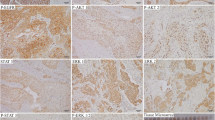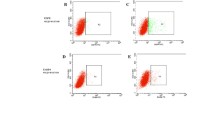Abstract
Overexpression of epidermal growth factor receptor (EGFR) was shown for the majority of squamous cell carcinomas. The EGFR expression correlates to tumour size, stage and cytoplasmic accumulation of the laminin-5 γ2 chain (Ln-5/γ2), which is known as a marker of invading tumour cells. There is only limited knowledge if and how EGFR signalling pathways are important for invasion-associated processes and for the regulation of Ln-5/γ2. Therefore the distribution of phosphorylated Erk1/2, p38 MAPK and Akt was immunohistochemically defined in oral squamous cell carcinoma (OSCC) of different histological grade and compared to histological criteria of invasion and cytoplasmic Ln-5/γ2 deposition. With raising histological grade, there is a slight increase in nuclear pErk1/2-stained tumour cells (P=0.398) and a loss of nuclear (P=0.593) and increased cytoplasmic staining (P=0.144) of pAkt mainly in invading OSCC cells. Nuclear pp38 MAPK could only be sporadically detected in few cases. In case of pErk1/2 and pAkt, only a partial co-localisation could be revealed in cases with abundant kinases and Ln-5/γ2. Among the investigated kinases, only pAkt shows a relation to histological grade and invasion in OSCC. pErk1/2, pp38 MAPK and pAkt do not represent a direct link between EGFR and Ln-5 synthesis. Therefore, enhanced Ln-5/γ2 may be a secondary phenomenon of EGFR-induced tumour cell proliferation and dissemination.



Similar content being viewed by others
References
Aguirre-Ghiso JA, Estrada Y, Liu D, Ossowski L (2003) ERK(MAPK) activity as a determinant of tumor growth and dormancy; regulation by p38(SAPK). Cancer Res 63:1684–1695
Albanell J, Codony-Servat J, Rojo F, Del Campo JM, Sauleda S, Anido J, Raspall G, Giralt J, Rosello J, Nicholson RI, Mendelsohn J, Baselga J (2001) Activated extracellular signal-regulated kinases: association with epidermal growth factor receptor/transforming growth factor alpha expression in head and neck squamous carcinoma and inhibition by anti-epidermal growth factor receptor treatments. Cancer Res 61:6500–6510
Amornphimoltham P, Sriuranpong V, Patel V, Benavides F, Conti CJ, Sauk J, Sausville EA, Molinolo AA, Gutkind JS (2004) Persistent activation of the Akt pathway in head and neck squamous cell carcinoma: a potential target for UCN-01. Clin Cancer Res 10:4029–4037
Bost F, McKay R, Bost M, Potapova O, Dean NM, Mercola D (1999) The Jun kinase 2 isoform is preferentially required for epidermal growth factor-induced transformation of human A549 lung carcinoma cells. Mol Cell Biol 19:1938–1949
Bryne M, Koppang HS, Lilleng R, Stene T, Bang G, Dabelsteen E (1989) New malignancy grading is a better prognostic indicator than Broders’ grading in oral squamous cell carcinomas. J Oral Pathol Med 18:432–437
Chen IH, Chang JT, Liao CT, Wang HM, Hsieh LL, Cheng AJ (2003) Prognostic significance of EGFR and Her-2 in oral cavity cancer in betel quid prevalent area cancer prognosis. Br J Cancer 89:681–686
Chun KH, Lee HY, Hassan K, Khuri F, Hong WK, Lotan R (2003) Implication of protein kinase B/Akt and Bcl-2/Bcl-XL suppression by the farnesyl transferase inhibitor SCH66336 in apoptosis induction in squamous carcinoma cells. Cancer Res 63:4796–4800
Gasparoni A, Chaves A, Fonzi L, Johnson GK, Schneider GB, Squier CA (2002) Subcellular localization of beta-catenin in malignant cell lines and squamous cell carcinomas of the oral cavity. J Oral Pathol Med 31:385–394
Grandis JR, Tweardy DJ (1993) TGF-alpha and EGFR in head and neck cancer. J Cell Biochem Suppl 17F:188–191
Grille SJ, Bellacosa A, Upson J, Klein-Szanto AJ, van Roy F, Lee-Kwon W, Donowitz M, Tsichlis PN, Larue L (2003) The protein kinase Akt induces epithelial mesenchymal transition and promotes enhanced motility and invasiveness of squamous cell carcinoma lines. Cancer Res 63:2172–2178
Habib AA, Chun SJ, Neel BG, Vartanian T (2003) Increased expression of epidermal growth factor receptor induces sequestration of extracellular signal-related kinases and selective attenuation of specific epidermal growth factor-mediated signal transduction pathways. Mol Cancer Res 1:219–233
Katoh K, Nakanishi Y, Akimoto S, Yoshimura K, Takagi M, Sakamoto M, Hirohashi S (2002) Correlation between laminin-5 gamma2 chain expression and epidermal growth factor receptor expression and its clinicopathological significance in squamous cell carcinoma of the tongue. Oncology 62:318–326
Kitagawa Y, Ueda M, Ando N, Ozawa S, Shimizu N, Kitajima M (1996) Further evidence for prognostic significance of epidermal growth factor receptor gene amplification in patients with esophageal squamous cell carcinoma. Clin Cancer Res 2:909–914
Klapper LN, Kirschbaum MH, Sela M, Yarden Y (2000) Biochemical and clinical implications of the ErbB/HER signaling network of growth factor receptors. Adv Cancer Res 77:25–79
Matsuda K, Idezawa T, You XJ, Kothari NH, Fan H, Korc M (2002) Multiple mitogenic pathways in pancreatic cancer cells are blocked by a truncated epidermal growth factor receptor. Cancer Res 62:5611–5617
Mishima K, Inoue K, Hayashi Y (2002) Overexpression of extracellular-signal regulated kinases on oral squamous cell carcinoma. Oral Oncol 38:468–474
Mukhopadhyay S, Munshi HG, Kambhampati S, Sassano A, Platanias LC, Stack MS (2004) Calcium induced matrix metalloproteinase 9 gene expression is differentially regulated by ERK1/2 and p38 MAPK in oral keratinocytes and oral squamous cell carcinoma. J Biol Chem 279(32):33139–33146
Munshi HG, Wu YI, Mukhopadhyay S, Ottaviano AJ, Sassano A, Koblinski JE, Platanias LC, Stack MS (2004) Differential regulation of membrane-type 1 matrix metalloproteinase activity by ERK 1/2- and p38 MAPK-modulated tissue inhibitor of metalloproteinases 2 expression controls TGF-beta1-induced pericellular collagenolysis. J Biol Chem 279(37):39042–39050
Nakayama H, Ikebe T, Beppu M, Shirasuna K (2001) High expression levels of nuclear factor kappaB, IkappaB kinase alpha and Akt kinase in squamous cell carcinoma of the oral cavity. Cancer 92:3037–3044
Ono Y, Nakanishi Y, Gotoh M, Sakamoto M, Hirohashi S (2002) Epidermal growth factor receptor gene amplification is correlated with laminin-5 gamma2 chain expression in oral squamous cell carcinoma cell lines. Cancer Lett 175:197–204
Osaki M, Oshimura M, Ito H (2004) PI3K-Akt pathway: its functions and alterations in human cancer. Apoptosis 9:667–676
Prenzel N, Fischer OM, Streit S, Hart S, Ullrich A (2001) The epidermal growth factor receptor family as a central element for cellular signal transduction and diversification. Endocr Relat Cancer 8:11–31
Price DJ, Avraham S, Feuerstein J, Fu Y, Avraham HK (2002) The invasive phenotype in HMT-3522 cells requires increased EGF receptor signaling through both PI 3-kinase and ERK 1,2 pathways. Cell Commun Adhes 9:87–102
Rommel C, Clarke BA, Zimmermann S, Nunez L, Rossman R, Reid K, Moelling K, Yancopoulos GD, Glass DJ (1999) Differentiation stage-specific inhibition of the Raf-MEK-ERK pathway by Akt. Science 286:1738–1741
Sawair FA, Irwin CR, Gordon DJ, Leonard AG, Stephenson M, Napier SS (2003) Invasive front grading: reliability and usefulness in the management of oral squamous cell carcinoma. J Oral Pathol Med 32:1–9
Schenk S, Hintermann E, Bilban M, Koshikawa N, Hojilla C, Khokha R, Quaranta V (2003) Binding to EGF receptor of a laminin-5 EGF-like fragment liberated during MMP-dependent mammary gland involution. J Cell Biol 161:197–209
Segrelles C, Ruiz S, Perez P, Murga C, Santos M, Budunova IV, Martinez J, Larcher F, Slaga TJ, Gutkind JS, Jorcano JL, Paramio JM (2002) Functional roles of Akt signaling in mouse skin tumorigenesis. Oncogene 21:53–64
Tangkijvanich P, Santiskulvong C, Melton AC, Rozengurt E, Yee HF Jr (2002) p38 MAP kinase mediates platelet-derived growth factor-stimulated migration of hepatic myofibroblasts. J Cell Physiol 191:351–361
Testa JR, Bellacosa A (2001) AKT plays a central role in tumorigenesis. Proc Natl Acad Sci U S A 98:10983–10985
Tikhomirov O, Carpenter G (2004) Ligand-induced, p38-dependent apoptosis in cells expressing high levels of epidermal growth factor receptor and ErbB-2. J Biol Chem 279:12988–12996
Veitch DP, Nokelainen P, McGowan KA, Nguyen TT, Nguyen NE, Stephenson R, Pappano WN, Keene DR, Spong SM, Greenspan DS, Findell PR, Marinkovich MP (2003) Mammalian tolloid metalloproteinase, and not matrix metalloprotease 2 or membrane type 1 metalloprotease, processes laminin-5 in keratinocytes and skin. J Biol Chem 278:15661–15668
Westermarck J, Li S, Jaakkola P, Kallunki T, Grenman R, Kahari VM (2000) Activation of fibroblast collagenase-1 expression by tumor cells of squamous cell carcinomas is mediated by p38 mitogen-activated protein kinase and c-Jun NH2-terminal kinase-2. Cancer Res 60:7156–7162
Acknowledgements
The authors would like to thank Christiane Geier, Carola König and Barbara Bergholz for excellent technical assistance. The study was partially supported by the Associazione Italiana per la Ricerca sul Cancro (AIRC), by the Thuringian Ministry of Science, Research and Art (ThMWFK) and IZKF of the University Jena (B307-01028 and B307-04004) and by the European Community (FP6, LSH-CT-2003-5032, STROMA; this publication reflects only the authors’ view. The European Commission is not liable for any use that may be made of the information contained.)
Author information
Authors and Affiliations
Corresponding author
Rights and permissions
About this article
Cite this article
Richter, P., Böhmer, F.D., Hindermann, W. et al. Analysis of activated EGFR signalling pathways and their relation to laminin-5 γ2 chain expression in oral squamous cell carcinoma (OSCC). Histochem Cell Biol 124, 151–160 (2005). https://doi.org/10.1007/s00418-005-0001-4
Accepted:
Published:
Issue Date:
DOI: https://doi.org/10.1007/s00418-005-0001-4




